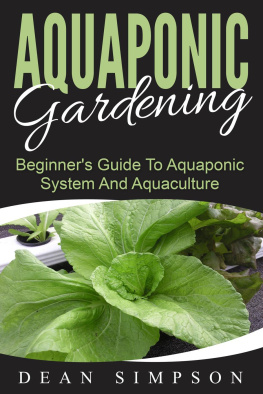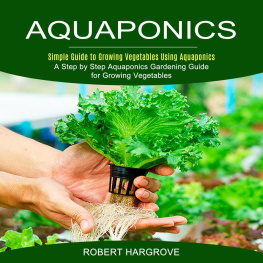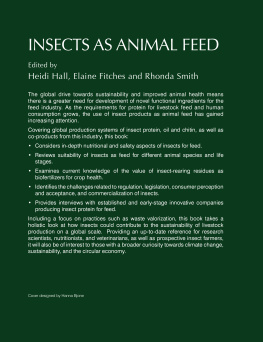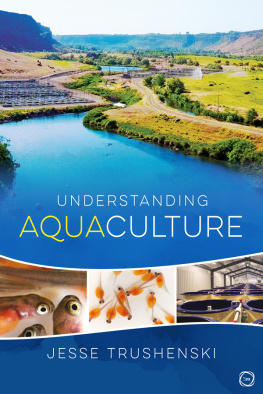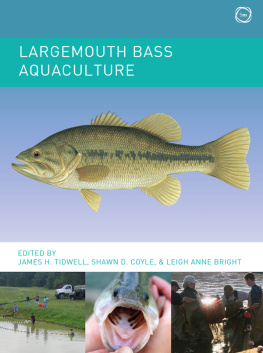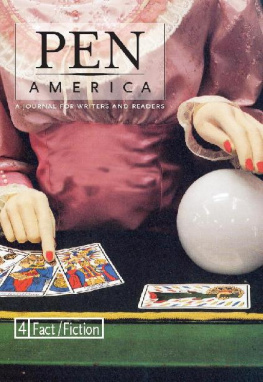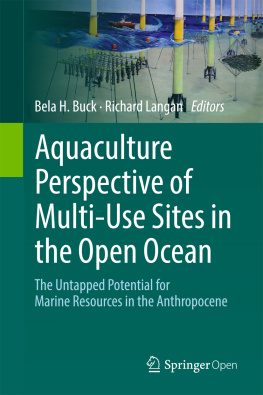Aquaculture in America
First published 1990 by Westview Press
Published 2018 by Routledge
52 Vanderbilt Avenue, New York, NY 10017
2 Park Square, Milton Park, Abingdon, Oxon OX14 4RN
Routledge is an imprint of the Taylor & Francis Group, an informa business
Copyright 1990 by Taylor & Francis
All rights reserved. No part of this book may be reprinted or reproduced or utilised in any form or by any electronic, mechanical, or other means, now known or hereafter invented, including photocopying and recording, or in any information storage or retrieval system, without permission in writing from the publishers.
Notice:
Product or corporate names may be trademarks or registered trademarks, and are used only for identification and explanation without intent to infringe.
Library of Congress Cataloging-in-Publication Data
Tiddens, Art.
Aquaculture in America : the role of science, government, and the
entrepreneur / by Art Tiddens.
p. cm. -- (Westview special studies in agriculture science
and policy)
Includes bibliographical references.
ISBN 0-8133-8018-9
1. Aquaculture industry--United States. 2. Aquaculture--United
States. I. Title.
HD9455.T53 1990
338.17980973--dc20
90-32925
CIP
ISBN 13: 978-0-367-01557-2 (hbk)
FOR FAMILY AND FRIENDS
(What Else Really Matters!)
AND
TO HEATHER,
Who Knows About Molecules, Sparks, and Waves
O Oysters, come and walk with us!
The Walrus did beseech.
A pleasant walk, a pleasant talk,
Along the briny beach.
And thick and fast they came at last,
And more, and more, and more
All hopping through the frothy waves,
And scrambling to the shore.
Lewis Carroll
The Walrus and the Carpenter
Things are seldom what they seem. When I first began working in the aquaculture industry a decade ago as a biochemist, I believed that aquaculture was all about marine scientists courageously working long hours to solve complicated scientific and technical problems. If we were smart enough and worked hard enough our hatcheries and production systems would succeed and our companies would prosper. From where I stood, the aquaculture equation was that simple. However well-meaning, it was a naive approach, and one that is surprisingly commonplace among scientists, entrepreneurs, investors, and the public at large.
There is a part in each of us that wants to believe in alchemy: that in business we can, with some simple scientific formula, turn lead into gold. But this is certainly not the case with American aquaculture. While there is no question as to the vital importance of scientific and technical expertise in aquaculture, non-technical factors also play a crucial role. As often as not, these factors determine the success or failure of an aquaculture enterprise.
While much has been written on aquaculture, most is of a scientific, or how to do it, nature. Next to nothing has been published about the industry as a whole and the non-technical factors that have had such a profound influence on American aquaculture. I believe it is of little use to know how to spawn shrimp if you are unaware of the economics of shrimp as a commodity or the social-political climate that your shrimp business will try to fit into. Aquaculture is a business, and, as with any business, you need a complete picture. This book tries to supply that picture. It is about the forest, not the trees.
Since the research on this book was completed, little has changed in the American aquaculture community. A large and diverse group of government agencies still supports, promotes, and regulates the industry. This bureaucratic entanglement as well as competing interests have made life particularly hard for mariculturists in the coastal zone. The U.S. Department of Agriculture has launched an extensive shrimp farming development program, though shrimp prices are falling due to huge production increases in Southeast Asia. Investors are still pouring millions of dollars into aquaculture ventures and are still losing their money. Our annual seafood deficit has climbed beyond seven billion dollars.
There are positive developments. Aquaculture production in this country is steadily increasing. Catfish and trout farming are very successful and relatively stable industries. Aquaculture entrepreneurs are continuing to provide innovations that are starting to show economic viability; onshore raceway production of two-inch abalone and tank culture of striped bass are two such examples.
These days one of my tasks is to track the industry and analyze the financial prospects of aquaculture companies. For me, the science of aquaculture is just as exciting as it always was, but now it is part of a larger picture. I think this is a vital perspective for everyone concerned with aquaculture to keep in mindmost particularly, investors.
Art Tiddens
Santa Barbara
In the years spent researching and writing this book, many people in academia, industry, and government have been exceedingly generous in both time and information. Thank you all. Special thanks go to my friend and mentor, Larry Badash, whose patience and editing ability border on the divine.
While this book would not have been possible without their help, any errors or faults remain my own.
A. T.
1.
The Allure of Aquaculture
Aquaculture is aptly defined as the husbandry of aquatic plants and animals. But this definition is deceptively simple and can be stretched and pulled almost beyond recognition. As a rubric, aquaculture cuts a wide swath.
The culture of aquatic species has been practiced since the earliest recorded times. Yet, as a modern industry, it is still in its infancy. Hunting and gathering, displaced on land 15,000 years ago by more reliable methods, still outcompetes aquaculture in the seafood marketplace many times over. The gamut of contemporary aquaculture operations runs from stick and bag culture, used in Roman times, to those that use the best of twentieth century technology. Aquatic products are grown on the sea, in the sea, on coastal land, and in fresh water, hundreds of miles from any ocean. Cultured species include abalone and Zizania aquatica (wild rice), and everything in between.
On the one hand, aquaculture has been viewed as a means to promote world peace by providing low-cost animal protein to an exploding third world population. Pacem Maribus (peaceful seas) bespoke this idea, and aquaculture was to be a part of what many hoped would be a new era of international cooperation on oceans that were the common heritage of all mankind.
Yet in America, aquaculture was one of the soldiers that could help this country maintain its technological leadership in the oceanic arena, and help in the battle against a huge foreign trade deficit. Consequently, aquaculture, in the view of many, was deserving of the same kind of federal support that had launched its terrestrial cousin agriculture a century earlier. In this important new area of food production, the United States did not want to be left behind.
Aquatic scientists had their own views on aquaculture. Their work was directly responsible for introducing modern aquaculture with its huge gains in production efficiencies. Some saw aquaculture as a natural recipient of their efforts, and like their agriculture counterparts, viewed themselves as the research arm of an essential industry. More than a few scientists left the public sector, seeking wealth and success through their own aquaculture enterprises. Aquaculture needed science, and maybe science needed aquaculture.



